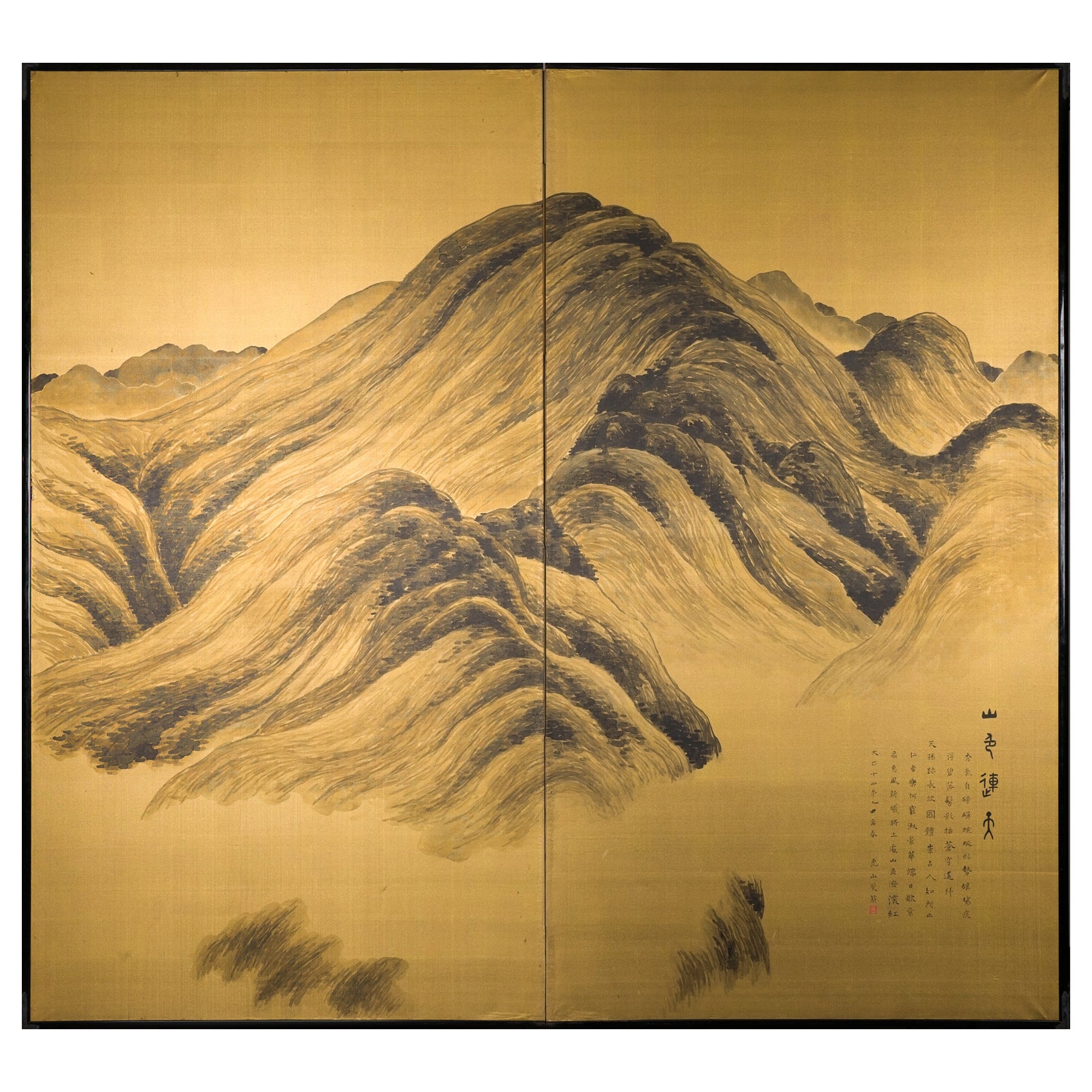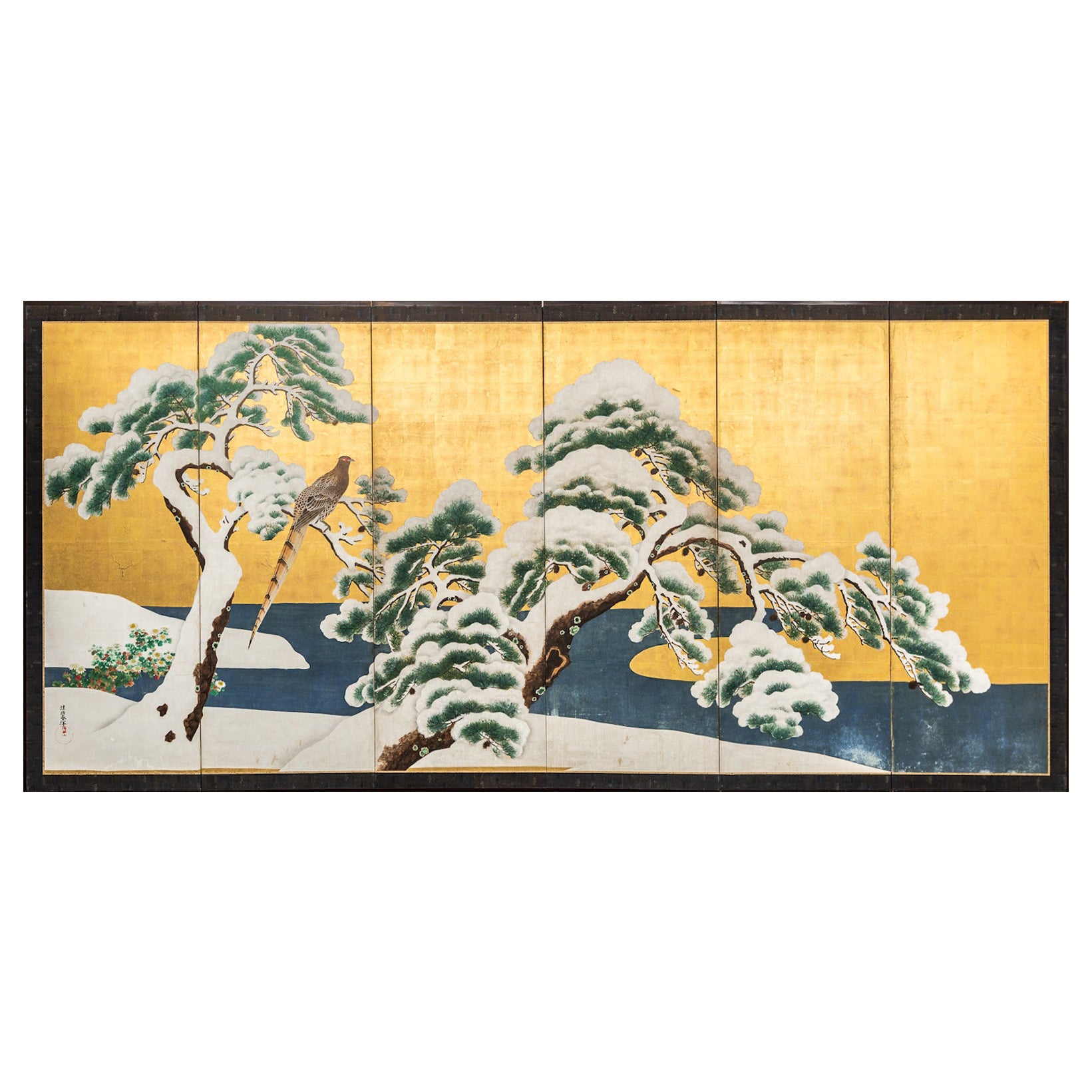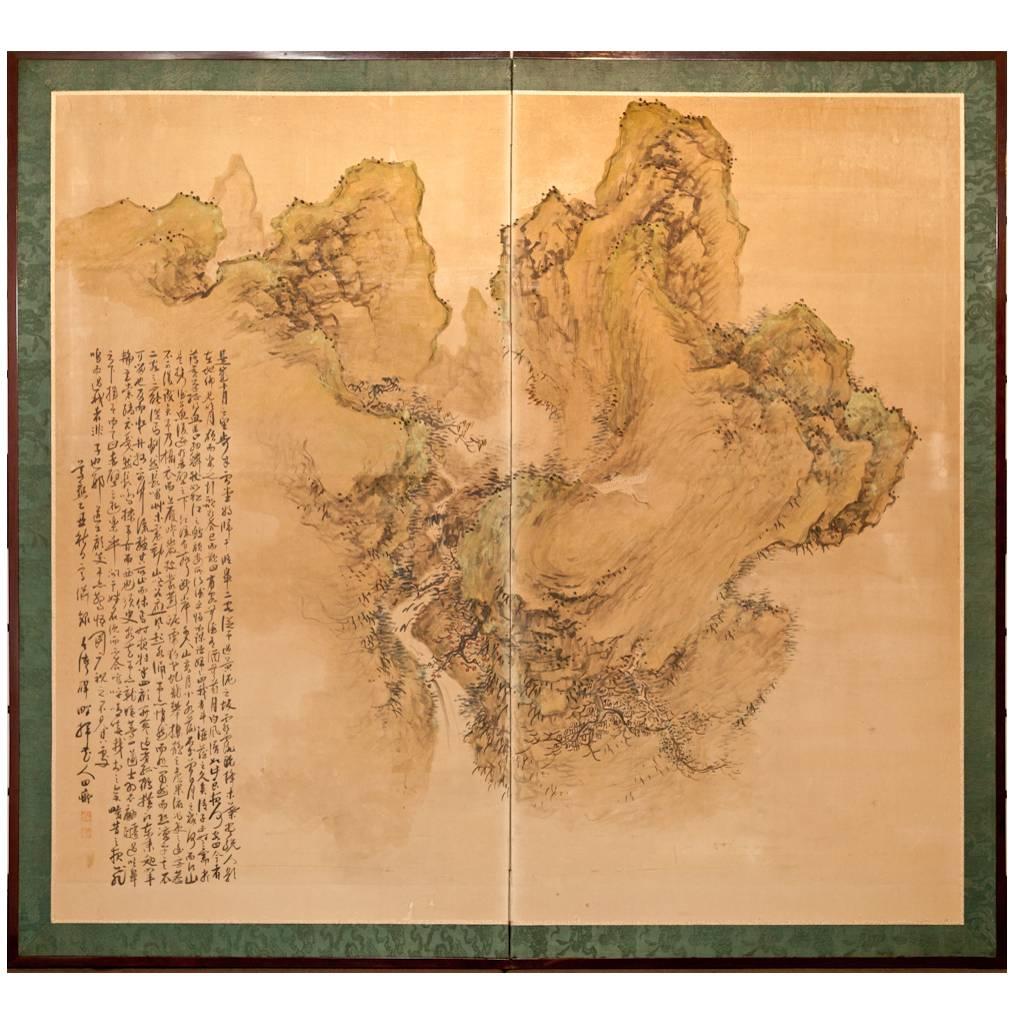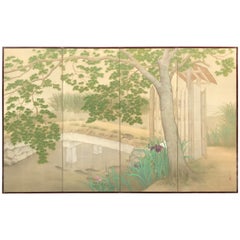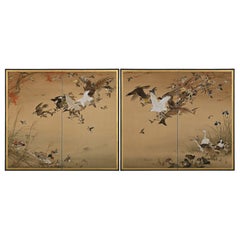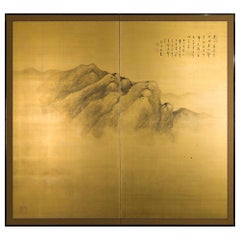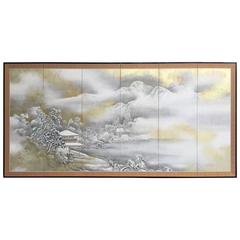
Japan Mountain Country Home Six-Panel Silk Screen, Hasegawa Gyokujun, Fine
View Similar Items
Want more images or videos?
Request additional images or videos from the seller
1 of 11
Japan Mountain Country Home Six-Panel Silk Screen, Hasegawa Gyokujun, Fine
About the Item
- Dimensions:Height: 68.75 in (174.63 cm)Width: 141 in (358.14 cm)Depth: 1.5 in (3.81 cm)
- Style:Taisho (Of the Period)
- Materials and Techniques:
- Place of Origin:
- Period:
- Date of Manufacture:Early 20th Century
- Condition:Wear consistent with age and use.
- Seller Location:South Burlington, VT
- Reference Number:1stDibs: LU128925292383
About the Seller
5.0
Gold Seller
These expertly vetted sellers are highly rated and consistently exceed customer expectations.
Established in 1990
1stDibs seller since 2015
2,214 sales on 1stDibs
Typical response time: 1 hour
More From This SellerView All
- Japanese Four Panel Garden Screen with Koi, Iris, & TurtlesLocated in South Burlington, VTUnusual Japanese Four Panel Garden Screen, Mint Condition Japan, a superb four-panel silk screen byobu depicting a panoramic garden replete with koi, turtles, Iris nestled near a walking bridge and wooden roofed shelter. This attractive screen dates to the early Taisho period. It is signed Tae. It is beautifully hand painted with a handsome gold natural light background by a skillful artist painter and is signed with inscription and seal in lower right corner: Dimensions: 69 inches high and 113 inches wide extended. Enticing and rare subject matter, this simple rendition of a serene nature setting and size of painting is skillfully and tastefully rendered in mineral paint pigments on silk and with muted soft green and off-white tones depicting a serene nature walk. Perhaps this is someone's dream tea garden. A red lacquered wood perfectly frames this serene and tasteful composition. Photographed in natural light. Lifetime guarantee of authenticity: All of our Asian works of art come with our Lifetime Authenticity Guarantee. We are members of the North American Japanese Garden...Category
Early 20th Century Japanese Taisho Paintings and Screens
MaterialsSilk
- Japanese Antique Playful Rabbit Family Amidst Flowers Two Panel ScreenLocated in South Burlington, VTJapan, a small and unusual two panel tea screen of four playful rabbits amidst pink and white flowers in, byōbu. It dates to the Taisho period. Dimensions: 41 inches high and 56 i...Category
Early 20th Century Japanese Taisho Sculptures and Carvings
MaterialsSilk, Wood
- Japan Small Folding Two-Panel Furosaki Tea Screen "Contemporary Simplicity"Located in South Burlington, VTJapan folding two-panel tea screen furosaki byobu depicting a simple cream colored back ground with a blue snow flake border, colors on paper 21.5” high and...Category
Mid-20th Century Japanese Showa Paintings and Screens
MaterialsPaper
$199 Sale Price59% Off - Japanese Fine Antique Currency Exchange Shop Sign, Hand CarvedLocated in South Burlington, VTJapan, a beautifully handmade and hand carved black lacquer colored antique shop sign -kanban- for a Japanese currency exchange shop. The kanji translates to "currency exchange". Many antique Japanese shop signs...Category
Antique Late 19th Century Japanese Taisho Sculptures and Carvings
MaterialsWood
- Japanese Fine Hand Carved Pair Flying Cranes With Matsu Trees Ranma ScreenLocated in South Burlington, VTJapan, a fine hand carved wooden screen "ranma" or transom featuring a spectacular composition of a pair (2) of finely carved flying cranes among matsu trees executed in kuri (chestnut wood), circa 1950s. In Japan, the crane, or tsuru, is a national treasure and is considered the bird of happiness...Category
Mid-20th Century Japanese Showa Paintings and Screens
MaterialsWood
- Chinese Wavy Mountains Stone Landscape Screen, SignedLocated in South Burlington, VTChinese "Wavy" Mountains Stone Landscape Screen With Original Black wood Display Stand Signed lower right. Impressive work of art with original wooden display stand. Dimensions: ...Category
Mid-20th Century Chinese Qing Paintings and Screens
MaterialsStone, Marble
You May Also Like
- Meiji Period Japanese Screen Pair, One Hundred Birds by Hasegawa GyokujunLocated in Kyoto, JPOne hundred birds Hasegawa Gyokujun (1863-1921) Meiji period, circa 1900. Ink, color and gofun on silk. Dimensions of each screen: H. 170 cm x W. 190 cm (67’’ x 75”) Despite the title, well over 100 birds are represented in this pair of two-fold Japanese screens (the title functions figuratively to convey the idea of a large number). The monumental work is rendered with a comprehensive and highly complex composition which is exquisitely executed and meticulously colored. More a celebration of naturalism than the traditional “One Hundred Birds” paintings which originated in China. This was a subject matter known for its auspicious meaning as much as its actual depiction of nature. These paintings generally had a phoenix (occasionally peacocks) placed in the center, and the other birds paying homage to it. In this quintessentially Japanese scene painted by Gyokujun, a couple of long-tailed birds modeled after paradise flycatchers are included; these are traditional auspicious motifs in Oriental bird and flower painting and denote themes such as celebration and enduring generations. In addition there is the playful inclusion of single exotic parrot. Even so, the vast majority of the birds and flowers are native to Japan. Reading the scene from right to left, from spring through to autumn, the overwhelming sense is one of movement and haste. It is almost as if the birds are in a race, with the fleetest leading the way forward. Although these native birds were commonly drawn amongst artists of the Shijo school, rarely were they painted with such drama and dynamism. It is not strictly a depiction of sketched birds whose manner was faithfully handed down through the traditions of the Shijo school. Rather we see Gyokujun seeking and achieving new expressions in the heart of the turbulent Meiji period. Hasegawa Gyokujun (1863-1921) was born in Kyoto. He was the eldest son of Hasegawa Gyokuho, a Shijo school painter who studied under Matsumura Keibun. Gyokujun studied painting under his father and became a prominent member of the Kyoto painti ng world from a young age. In 1891 he established the ‘Young Painters Social Club’ along with Takeuchi Seiho, Miyake Gogyo and Taniguchi Kokyo. Also in 1891 he was selected as a judge of the Great Private Paintings Exhibition along with Takeuchi Seiho, Yamamoto Shunkyo...Category
Antique Early 1900s Japanese Meiji Paintings and Screens
MaterialsSilk, Wood
- Japanese Six Panel Screen: Rolling Country LandscapeLocated in Hudson, NYA mid-sized six panel screen. Edo period (c. 1800) painting of a landscape features a temple on the mountain top, a river with fishermen emerging from gold...Category
Antique Early 19th Century Japanese Edo Paintings and Screens
MaterialsGold Leaf
- Japanese Two Panel Screen: Mountains in the MistLocated in Hudson, NYChinese School landscape ink painting on gilded silk by Yukimatsu Shunpo, signed and dated 1924. Yukimatsu Shunpo was born in Oita in 1897 and studied under Himejima Chikugai in Osak...Category
Early 20th Century Japanese Taisho Paintings and Screens
MaterialsSilk
- Japanese Two Panel Screen Mountain Landscape on Gold SilkLocated in Hudson, NYNanga School; by female artist Kia Kozan. Showa Period (1926-1989) Translation: Kai Kozan 1867-1961, from Bungo area in Kyushu. Graduated from Bunchu-en Girls School. Signature and s...Category
Mid-20th Century Japanese Paintings and Screens
MaterialsPaper
- Japanese Four Panel Screen, Snowy Mountain LandscapeLocated in Hudson, NYHinoki (Japanese red pine) and other deciduous trees in mineral pigments on mulberry paper. Signature reads: Yosui.Category
Early 20th Century Japanese Paintings and Screens
MaterialsPaper
- Japanese Four Panel Screen Tibetan Mountain MonasteryLocated in Hudson, NYPowerful depiction of sprawling monastery with massive mountains in the background. Ink on paper. Signature and seal read: Tetsuzan.Category
Antique Early 19th Century Japanese Paintings and Screens
MaterialsPaper
Recently Viewed
View AllMore Ways To Browse
Antique Asian Silk Screen
Antique Chinese Lacquered Screen
Antique Black Chinese Screen
Large 3 Panel Screen
Japanese 20th Century Six Panel Screen
Japanese Screen 3
Antique Japanese Painted Panel Wood
Asian 3 Panel Screen
Antique 3 Panel Screen
Chinese Black Silk Screen
Kyoto Silk Painting
Low Screen Panels
Chinese Panel Screen 3
Antique Japanese Black Lacquer Panels
3 Panel Silk Screen
Lacquered Screen European
Six Panel Antique Japanes Screens
Antique Chinese Painting On Silk Panel



